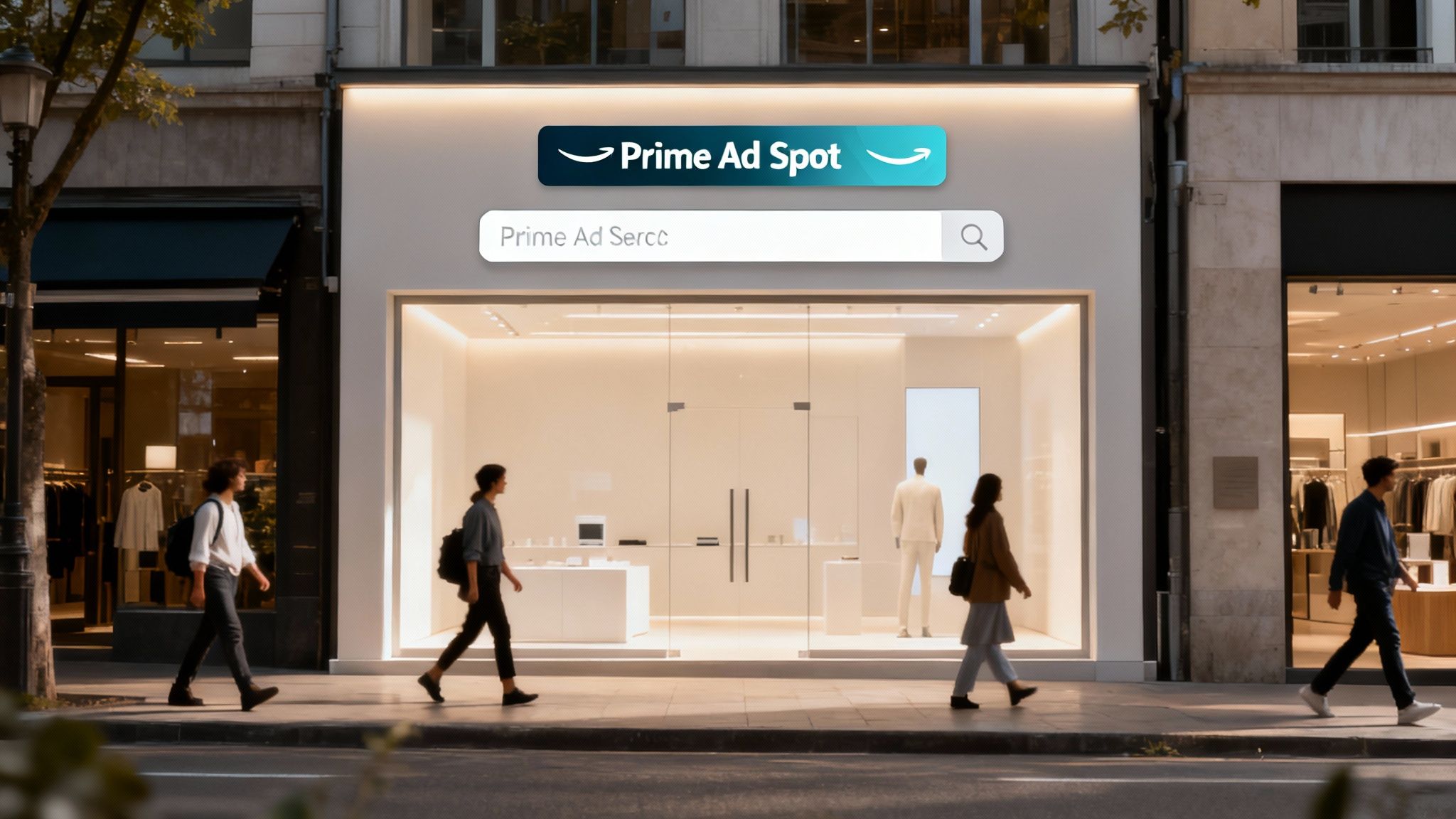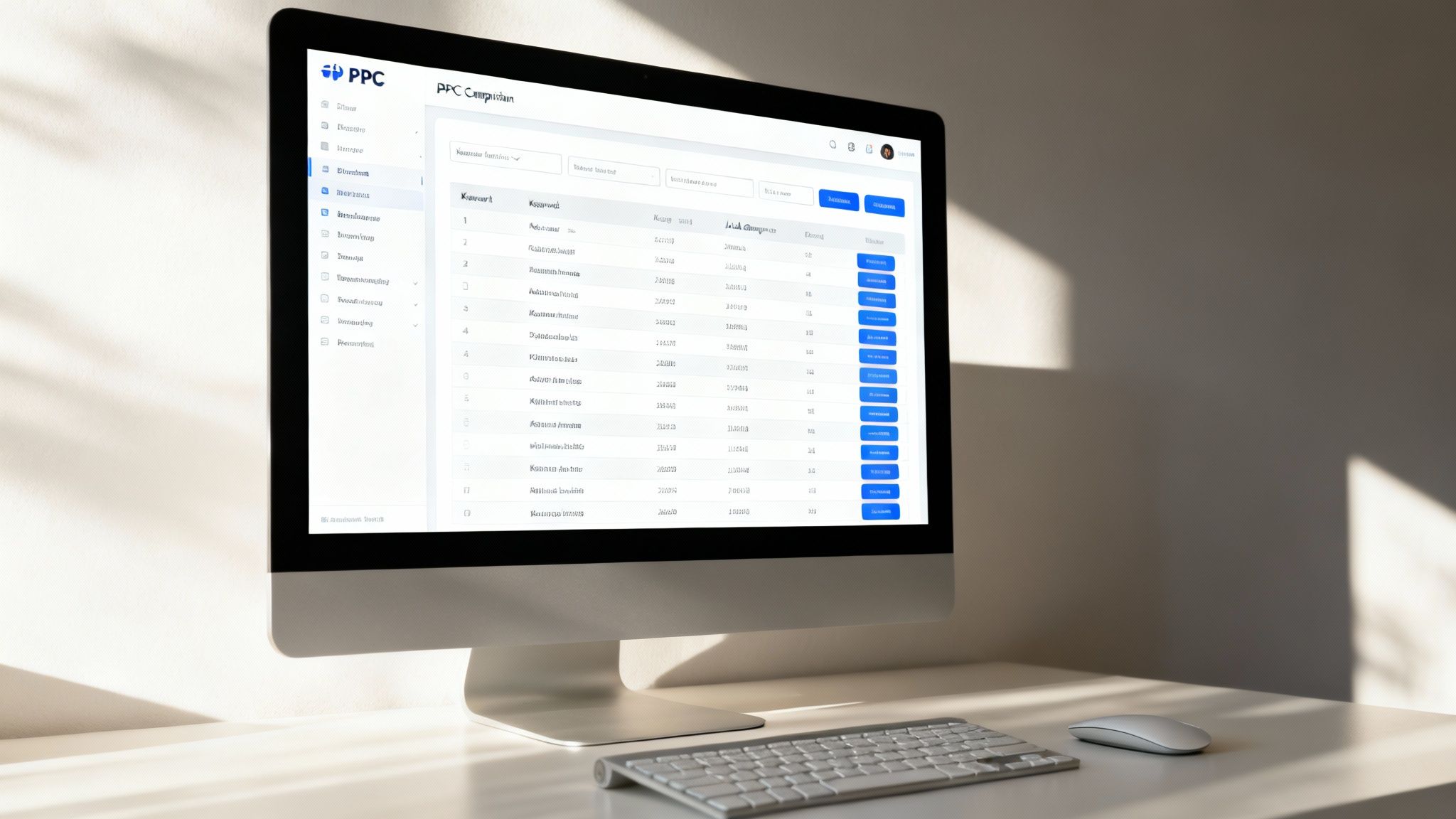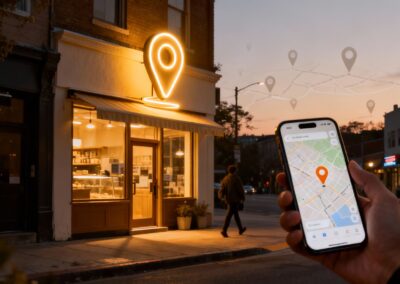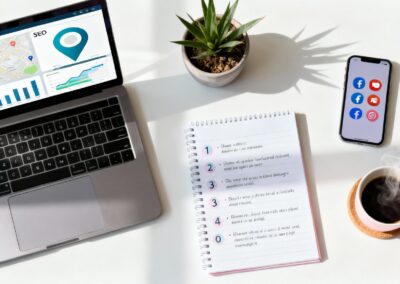If you’re a small business owner, think of Pay-Per-Click (PPC) advertising as renting a pop-up shop on the busiest street on the internet. It puts your business directly in front of people who are actively searching for exactly what you sell. It's a direct line to motivated customers right when they need you most.
Why PPC Matters for Your Small Business

PPC is an advertising model where you only pay a small fee when someone clicks on your ad. It’s that simple. While SEO can take months to show results, PPC can start sending traffic to your website almost overnight. For a small business that needs to make an impact now, that speed is everything.
The whole system works like a real-time auction. Every time someone types a search into Google, an auction instantly runs behind the scenes to decide which ads get shown. But here’s the best part: it’s not just about who has the deepest pockets. Google also looks at how relevant and helpful your ad is. This means a small business with a smart ad can absolutely outrank a huge competitor with a lazy one.
Understanding the Core Concepts
Getting started with PPC only requires knowing a few key terms. These aren't just jargon; they are the basic ingredients for every campaign you'll ever run.
- Impressions: Think of this as your ad's visibility. It’s simply the number of times your ad was displayed on a search results page.
- Clicks: This is the magic moment. A user saw your ad and clicked on it, landing on your website. This is the action you pay for.
- Conversions: This is the ultimate goal, the valuable action a visitor takes. It could be buying a product, filling out your contact form, or calling your shop.
These three metrics work together, telling you a clear story about your ad performance. You can track exactly how many people saw your ad, how many were interested enough to click, and how many turned into actual customers.
The real power of PPC for small businesses lies in its control and precision. You decide exactly how much you want to spend, who you want to reach, and what success looks like for your business.
Leveling the Playing Field
One of the toughest challenges for any small business is going up against bigger, established brands. PPC is a great equalizer. You don't need a Super Bowl-sized marketing budget to get in the game.
Instead of shouting to the masses, you can whisper directly to your perfect customer. PPC allows for incredibly specific targeting. You can zero in on people based on their location, age, interests, and even the type of phone they're using.
Imagine you run a local bakery. You could set your ads to only show to people within a five-mile radius who have searched for "custom birthday cakes near me." This kind of focus stops you from wasting money on people who will never buy from you and puts every penny toward qualified leads.
This is a world away from traditional advertising, where you pay for a billboard and just hope the right people drive by. PPC for small businesses is all about efficiency and seeing a clear return on your investment. While PPC is a broad term, it often refers to Paid Search advertising; to get a better handle on the basics, you can explore what is Paid Search.
Launching Your First Profitable PPC Campaign

Diving into the world of Pay-Per-Click can seem intimidating, but getting your first campaign off the ground is more straightforward than you might think. Success isn't about having the deepest pockets; it’s about laying a solid foundation right from the very beginning. Let’s walk through the essential steps to get you up and running.
If you're considering PPC, you're in good company. Roughly 65% of small to medium-sized businesses are already running paid ad campaigns, and over 80% of them rely on Google Ads as their go-to platform. It’s clear that paid search has become a core part of growing a business today. For a deeper dive into how small businesses are allocating their ad budgets, you can find some great insights on PPC advertising spend.
Start with a Clear Campaign Objective
Before you even think about keywords or ad copy, you have to answer one simple question: What do you want to achieve? A campaign without a clear goal is like driving in circles. You’ll burn through your budget without getting anywhere.
Your objective will be the North Star for every decision you make. Don't overthink it; for most small businesses, the goals are pretty direct.
- Generate More Leads: This is all about getting potential customers to fill out a contact form or, even better, call your business.
- Drive Online Sales: If you're running an e-commerce shop, your one and only goal is to sell more products right from your website.
- Increase Local Foot Traffic: For brick-and-mortar businesses, the aim is to get more people walking through your front door.
Think about it this way: a plumber's main goal is to get that phone ringing for an emergency repair. An online t-shirt store wants to see completed checkouts. Figure out your number one priority and build your entire campaign around it.
Find and Group Your Keywords
Keywords are the very heart of a search campaign. They're the bridge connecting a person's problem with your solution. Your job is to get inside your customer's head and figure out the exact phrases they’d type into Google.
Start by brainstorming a simple list of your core products or services. Then, put on your customer hat. What would you search for? Use a tool like Google’s free Keyword Planner to flesh out your list and get a feel for how many people are searching for those terms.
Once you have your list, the next step is crucial: organize them into tightly-themed ad groups. An ad group is just a small cluster of closely related keywords. This structure is absolutely essential for one simple reason: relevance.
By grouping similar keywords, you can write hyper-specific ads that speak directly to what the searcher is looking for. This boosts your ad's relevance, which Google rewards with a higher Quality Score and, often, lower costs per click.
Let's say you own a local bakery. You wouldn't throw "custom wedding cakes" and "fresh sourdough bread" into the same bucket. Instead, you’d create a separate ad group for each. That way, your ad for wedding cakes speaks to brides-to-be, and your sourdough ad targets someone looking for their daily bread. Some local businesses can also benefit from specific ad formats, and you can learn more in our guide on why small businesses need Local Service Ads.
Write Compelling Ad Copy
Think of your ad as your digital storefront window. You have just a few seconds to catch someone's eye and give them a reason to come inside. The best ads are clear, persuasive, and directly answer the searcher's question.
A winning ad usually contains three key ingredients:
- A Powerful Headline: Get your main keyword in here. Instantly show the user that you have exactly what they need.
- A Clear Benefit: Don't just list features; sell the solution. Instead of saying, "We Use Quality Materials," try "Durable Fences Built to Last a Lifetime." See the difference?
- A Strong Call to Action (CTA): Tell people exactly what to do next. Be direct with phrases like "Get Your Free Quote," "Shop the Sale," or "Call for a Free Estimate."
Here’s what that looks like in a simple, effective ad for a plumber:
| Element | Example Ad for a Plumber |
|---|---|
| Headline | 24/7 Emergency Plumber in [Your City] |
| Description | Fast & Reliable Service. We Fix It Right the First Time. |
| Call to Action | Call Now for Immediate Help |
This ad gets straight to the point. It’s simple, direct, and focused on solving the customer's urgent problem.
Create a Focused Landing Page
The final piece of the puzzle, and arguably the most important, is your landing page. This is the webpage someone sees immediately after clicking your ad. Your ad makes a promise; your landing page has to deliver on it.
A classic mistake is to send all your ad traffic straight to your homepage. Your homepage is designed to do a little bit of everything, which can be distracting. Instead, you need a dedicated page built for one single purpose: getting that conversion.
A great landing page has a bold headline that echoes the ad, reinforces the key benefits, and features a crystal-clear call to action. Strip away any distracting menus or links that might tempt the visitor to wander off. Your goal is to create a frictionless path from the ad click to the lead or sale.
Setting a Smart Budget and Bidding Strategy

If you’re a small business owner, every single dollar counts. The one question that holds most people back from diving into PPC is almost always, "How much is this actually going to cost me?"
The beauty of PPC is that you are in the driver's seat. Unlike old-school advertising that often demands a huge upfront commitment, PPC lets you start smart and small. The goal isn't to outspend your competition; it's to out-think them. You can test the waters, see what's actually working with real data, and then scale up your budget with confidence. This takes the guesswork out of the equation and turns your marketing into a reliable growth machine.
How to Figure Out a Starting Budget
You don't need a crystal ball to set your initial budget. The best way to come up with a realistic number is to simply work backward from your goals.
Let's imagine a local landscaping company that wants more leads for its lawn mowing service.
The owner knows that for every ten solid leads they get, they usually sign up two new clients. Each new client brings in about $500 in profit for the season. A little quick math shows that each lead is worth an average of $100 to the business ($1,000 total profit divided by 10 leads). This value per lead is your North Star.
Next, a quick look at keyword research tools shows the average cost-per-click (CPC) for a term like "lawn mowing service near me" is around $4.00. To get started, the owner decides they want to aim for 50 clicks in the first month to see what happens.
Your Simple Budget Formula:
50 Clicks x $4.00 Average CPC = $200 Starting Monthly Budget
Just like that, for $200, the landscaper can get their ads running, find out which keywords make the phone ring, and learn which ad copy connects with customers, all without a massive financial risk.
Choosing Your Bidding Strategy
With a budget in place, you now need to tell the ad platform how to spend it. This is your bidding strategy, and it’s basically your instruction manual for the ad auction. When you're just starting, there are two main approaches that make the most sense.
Manual vs. Automated Bidding
Manual CPC (Cost-Per-Click): This puts you in total control. You tell the platform the absolute maximum you’re willing to pay for a single click on a keyword. It’s fantastic for beginners because it forces you to keep a close eye on your spending and prevents you from accidentally blowing your budget on keywords that aren't performing.
Automated Bidding: This is where you let the platform's algorithm do the heavy lifting. Bidding strategies like "Maximize Clicks" or "Maximize Conversions" automatically adjust your bids to hit a specific goal. For newcomers, "Maximize Clicks" is a great place to start. Its only job is to get you the most possible traffic for your daily budget.
For most small business owners, kicking things off with Manual CPC or Maximize Clicks is the safest and smartest move. You get to collect crucial performance data before you let the platform's automation take over.
This careful approach is worth it. Globally, search ad spending is projected to reach an incredible $351.5 billion by 2025. More importantly, on average, PPC delivers a 200% return on investment. That means businesses typically earn back $2 for every $1 they spend. You can dig into more of these powerful PPC statistics and their impact to see the full picture.
The Tangible Benefits of PPC Advertising
So, beyond all the technical jargon and budget spreadsheets, what does PPC actually do for your small business? The answer is simple: it delivers direct, impactful results with a level of speed and control that most other marketing channels just can't touch. This is where your investment starts to feel like real, measurable growth.
Think of it this way: SEO is a fantastic long-term play, but it’s like planting an oak tree. It needs time, nurturing, and a lot of patience before it provides any shade. PPC, on the other hand, is like flipping a light switch. The moment your campaign goes live, your ads can be sitting right at the top of Google, putting your brand in front of motivated customers from day one.
Immediate Visibility and Rapid Results
That instant visibility is a total game-changer, especially when you're a small business trying to get noticed in a crowded market. You don’t have to wait months to find out if your marketing is working. You can launch a campaign for a new service or a weekend promotion and start getting traffic and collecting crucial data within hours.
This is the power of a direct line to your customers.

As you can see, PPC creates a clear, traceable path from your ad spend straight to interested buyers, making it incredibly straightforward to see your return on investment.
Full Control and Total Transparency
One of the best things about PPC is the sheer amount of control it gives you. You set the rules. You decide exactly how much you’re willing to spend each day and what you'll pay for a single click, which means you never have to worry about your budget spiraling out of control. There are no surprise fees or long-term contracts trying to lock you in.
This transparency carries over to performance, too. You get a behind-the-scenes look at what’s really working. You can see which keywords are driving clicks, which ad copy is converting into sales, and exactly what it costs to land each new customer. This isn't guesswork; it's data-driven decision-making at its finest.
With PPC, every dollar is accountable. You can draw a straight line from your ad spend to your revenue, giving you a crystal-clear understanding of your return on investment (ROI).
Powerful and Precise Customer Targeting
PPC's targeting capabilities are where things get really exciting, especially for a small business that needs to make every marketing dollar count. You can get laser-focused and find your ideal customer with surgical precision.
- Geo-Targeting: Only serve customers in a specific city or even a few zip codes? No problem. You can set your ads to show only to people in that location, eliminating wasted clicks from halfway across the country.
- Demographic Targeting: Want to reach a specific age group or gender? You can narrow your audience to connect with the people most likely to be interested in what you offer.
- Behavioral Targeting: This is a big one. You can show ads to people based on their recent search history and online behavior, catching them at the very moment their interest is highest.
This ability to hyper-focus your advertising means you're not just shouting into a crowd. You're having a direct, relevant conversation with someone who is actively looking for the exact solution you provide.
To put this all into context, it's helpful to see how paid ads stack up against organic efforts like SEO. Each has its place, but they serve very different purposes.
PPC vs. Organic SEO: A Quick Comparison for Small Businesses
This table breaks down the key differences to help you see where each strategy might fit into your marketing plan.
| Feature | PPC (Paid Search) | Organic SEO |
|---|---|---|
| Speed of Results | Nearly instant; traffic can start the same day a campaign is launched. | Slow and steady; typically takes 3-6 months to see significant results. |
| Cost | You pay for every click, giving you direct control over your daily or monthly budget. | No direct cost per click, but requires a significant investment of time or money in content, outreach, and technical work. |
| Position on Page | Appears at the very top of the search results, clearly labeled as an "Ad" or "Sponsored." | Appears below the paid ads in the organic search results, earning its spot over time. |
| Measurability | Highly transparent; you can track ROI for every single keyword and ad with precision. | More complex to measure direct ROI; focuses on broader metrics like traffic growth and keyword ranking trends. |
Ultimately, both PPC and SEO are vital for a healthy, well-rounded digital strategy. But when you need fast, measurable, and highly targeted results to kickstart growth, PPC is an absolutely unmatched tool in the small business toolkit.
How to Measure and Optimize Your Campaigns
https://www.youtube.com/embed/mm8fVtmHx_g
Getting your first campaign live is a great feeling, but the real work starts now. This is where you shift from setup to optimization, and frankly, it's where you start making real money. Your campaign dashboard is like a live report card for your business. It shows you what’s hitting the mark, what’s falling flat, and exactly where you can tweak things to improve your return.
The trick is to avoid getting bogged down by the mountain of data available. For a small business, a few key numbers tell you everything you need to know about your campaign's health. If you focus on these, you can make sharp, data-driven decisions that directly boost your bottom line.
Key Metrics That Actually Matter
Don't get lost in a sea of analytics. Instead, zoom in on the metrics that track what you actually care about: getting interested customers in the door and turning a profit.
- Click-Through Rate (CTR): This is simply the percentage of people who see your ad and are intrigued enough to actually click on it. A low CTR is often a red flag that your ad copy isn't resonating or your keywords are a bit off target.
- Conversion Rate: This is the big one, the ultimate measure of success. It's the percentage of clicks that turn into a real business result, like a completed purchase or a filled-out contact form. A high CTR but a low conversion rate usually points to a problem with your landing page.
- Cost Per Acquisition (CPA): This is your bottom-line number. It tells you, in plain dollars, how much you're spending to get one new customer. As long as your CPA is lower than the profit you make from that customer, you're in the green.
Keeping a close eye on these three metrics gives you a powerful, at-a-glance view of your campaign's performance. Nailing down your CPA is especially vital for profitability, a concept you can dive deeper into by learning how to measure marketing ROI across all your marketing channels.
Actionable Tips for Immediate Improvement
Once you know how to read the story your data is telling, you can start making smart changes. Optimization isn’t about huge, risky overhauls; it's about making small, consistent adjustments that compound over time.
A fantastic starting point is to stop paying for irrelevant clicks. That’s where negative keywords come into play. Think of them as a "do not show" list for your ads. For example, if you sell premium running shoes, you’d want to add words like "cheap" or "free" to your negative keyword list to filter out bargain hunters who aren't your target customer.
Another powerful technique is A/B testing your ad copy. It’s simpler than it sounds. Just create two slightly different versions of an ad, maybe one has a different headline, and the other has a more urgent call to action. Run both at the same time and let the data show you which one gets a better CTR or conversion rate. It's a fantastic way to let your audience tell you what they want to hear.
Optimization is an ongoing process of listening to your data and responding with smart changes. The goal is to continuously refine your campaign so that every dollar you spend works harder for your business.
When done right, the power of paid advertising is hard to deny. Here’s a compelling stat: 46% of internet users can’t even tell the difference between a PPC ad and an organic search result. On top of that, traffic from PPC ads is 50% more likely to convert than organic traffic. For most businesses, this translates to an average of $2 in revenue for every $1 spent on Google Ads.
Finally, don’t be shy about adjusting your bids. Once you see which keywords are bringing in the most profitable conversions, it makes sense to bid a little higher on them to capture more of that valuable traffic. On the flip side, you can pull back on bids for keywords that get clicks but never seem to convert. To really get ahead, you need to master paid search intelligence. This kind of proactive management is what turns PPC from a simple advertising expense into a reliable engine for growth.
Common PPC Questions from Small Business Owners
Even with a solid plan, jumping into PPC for the first time can feel a little overwhelming. That's perfectly normal. To help clear things up, let's walk through a few of the most common questions we hear from small business owners who are right where you are.
How Quickly Can I See PPC Results?
This is where PPC really shines. Unlike SEO, which is a long game that can take months to show real traction, PPC ads can start bringing people to your website almost immediately. Once your ads are approved, you could see traffic within a few hours. Seriously, clicks and leads can start rolling in on day one.
But it's crucial to understand the difference between traffic and profitability. Getting those initial clicks is fast, but that first phase is all about gathering data. The real magic happens over the first few weeks and months as you use that data to fine-tune your campaigns and build a strong, predictable return on your investment.
Can I Run PPC Campaigns Myself?
Absolutely. You can definitely manage your own PPC campaigns, especially when you're starting out with a clear objective and a manageable budget. The ad platforms themselves have gotten much more intuitive over the years, and a guide like this one gives you the fundamental knowledge to get your foot in the door.
Think of it like any other skill you've learned for your business. Start small, stick to the basics, and let the data be your guide. As you scale up and things get more complex, you might decide to bring in an expert to save time or squeeze more performance out of your ads. But it's by no means a prerequisite for getting started and finding success.
What Is a Good Conversion Rate?
You'll often see articles throwing out industry averages, like 2-5%, but honestly, that number can be more distracting than helpful. What counts as a "good" conversion rate is completely unique to your business, your profit margins, and what a customer is worth to you.
Forget about chasing a generic benchmark. The number you should obsess over is your Cost Per Acquisition (CPA). If it costs you less to get a customer than the profit you make from them, your conversion rate is working just fine for your business.
For instance, a custom home builder could be ecstatic with a 1% conversion rate if each conversion leads to a six-figure project. On the other hand, someone selling $10 t-shirts online needs a much, much higher rate to stay in the black. The only question that matters is this: is your ad spend generating a positive, measurable return?
Ready to stop guessing and start growing? Digital Lotus Marketing specializes in creating data-driven PPC strategies that deliver measurable results for small businesses. Let us build a campaign that turns clicks into customers. Find out more at https://digitallotusmarketing.com.






